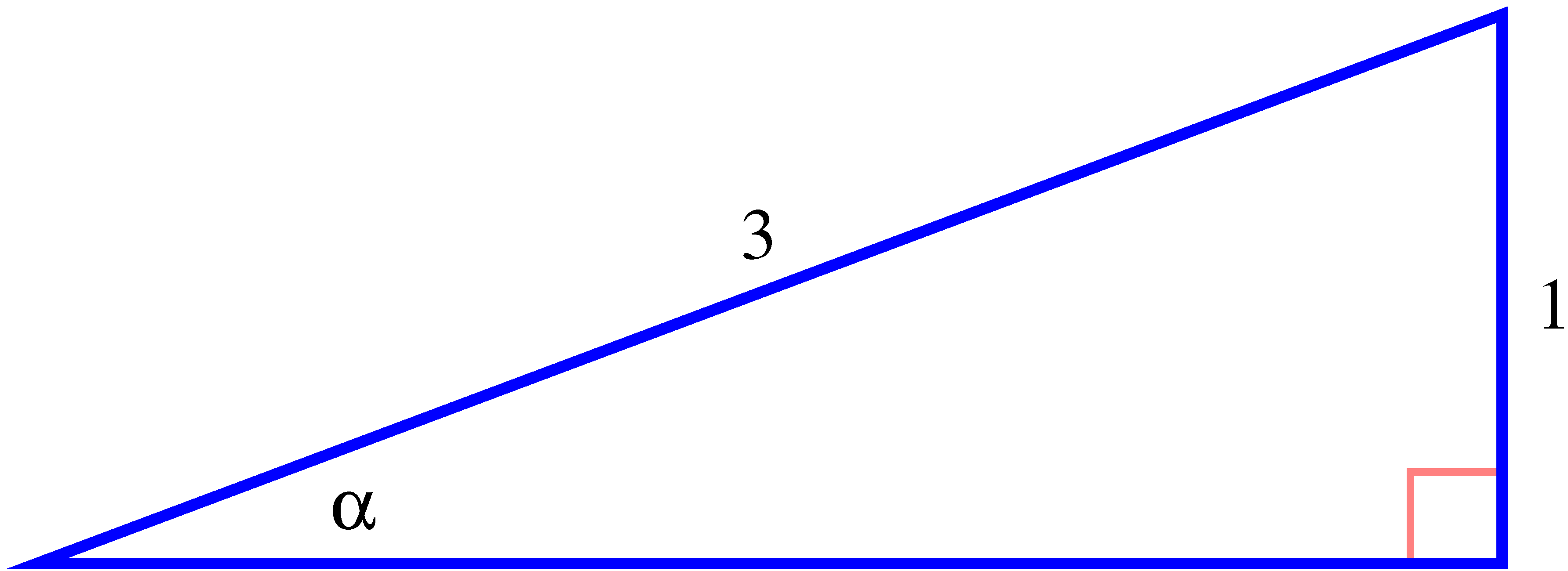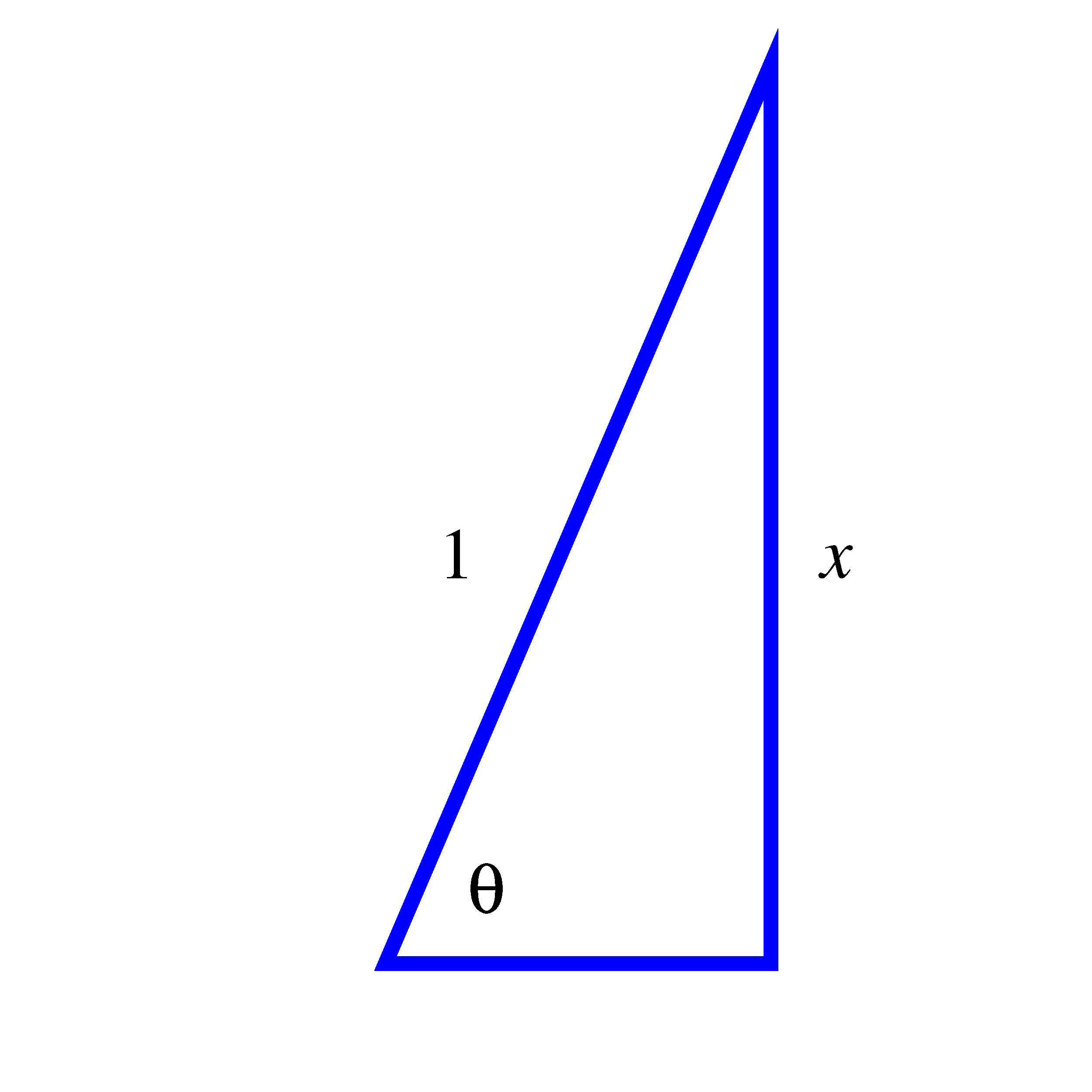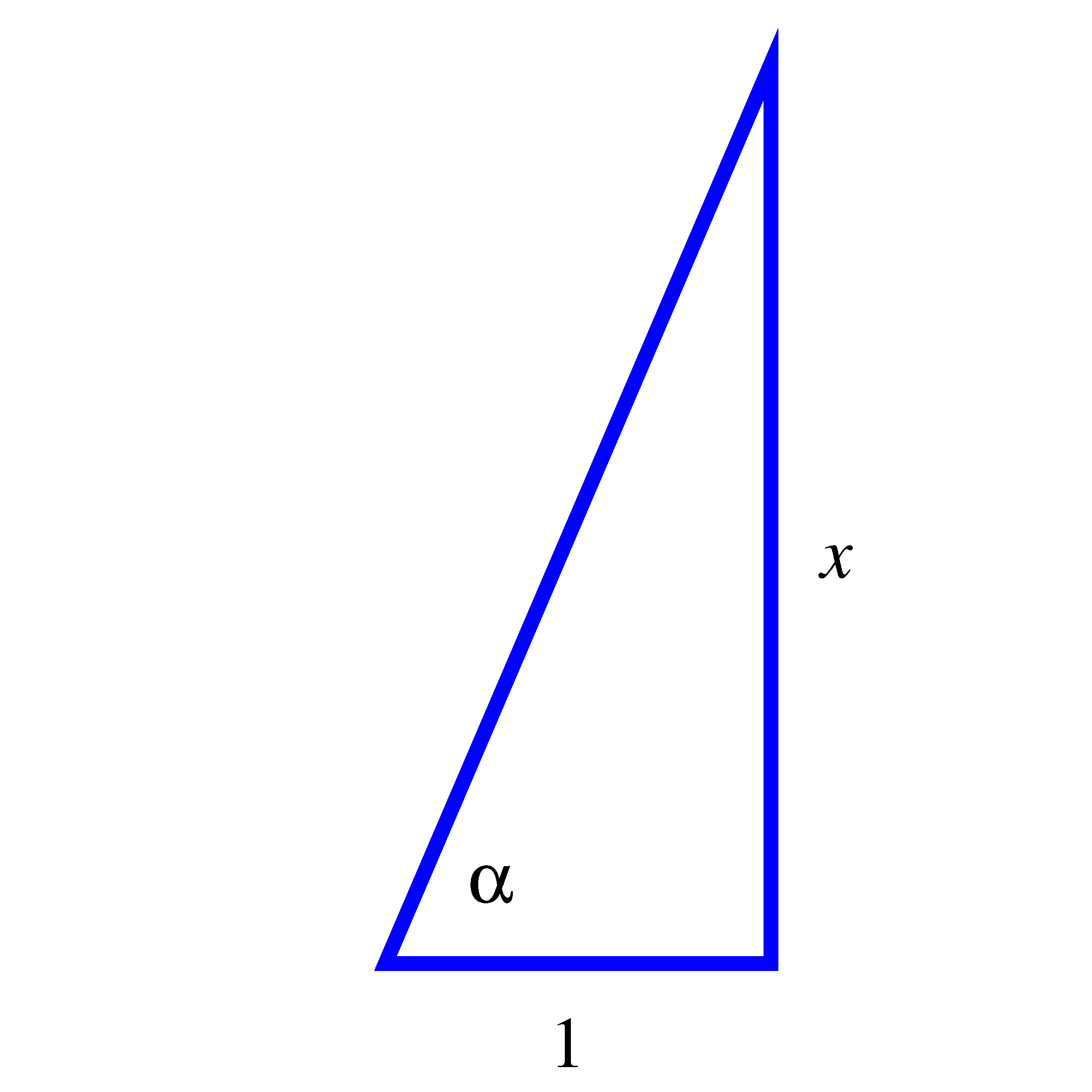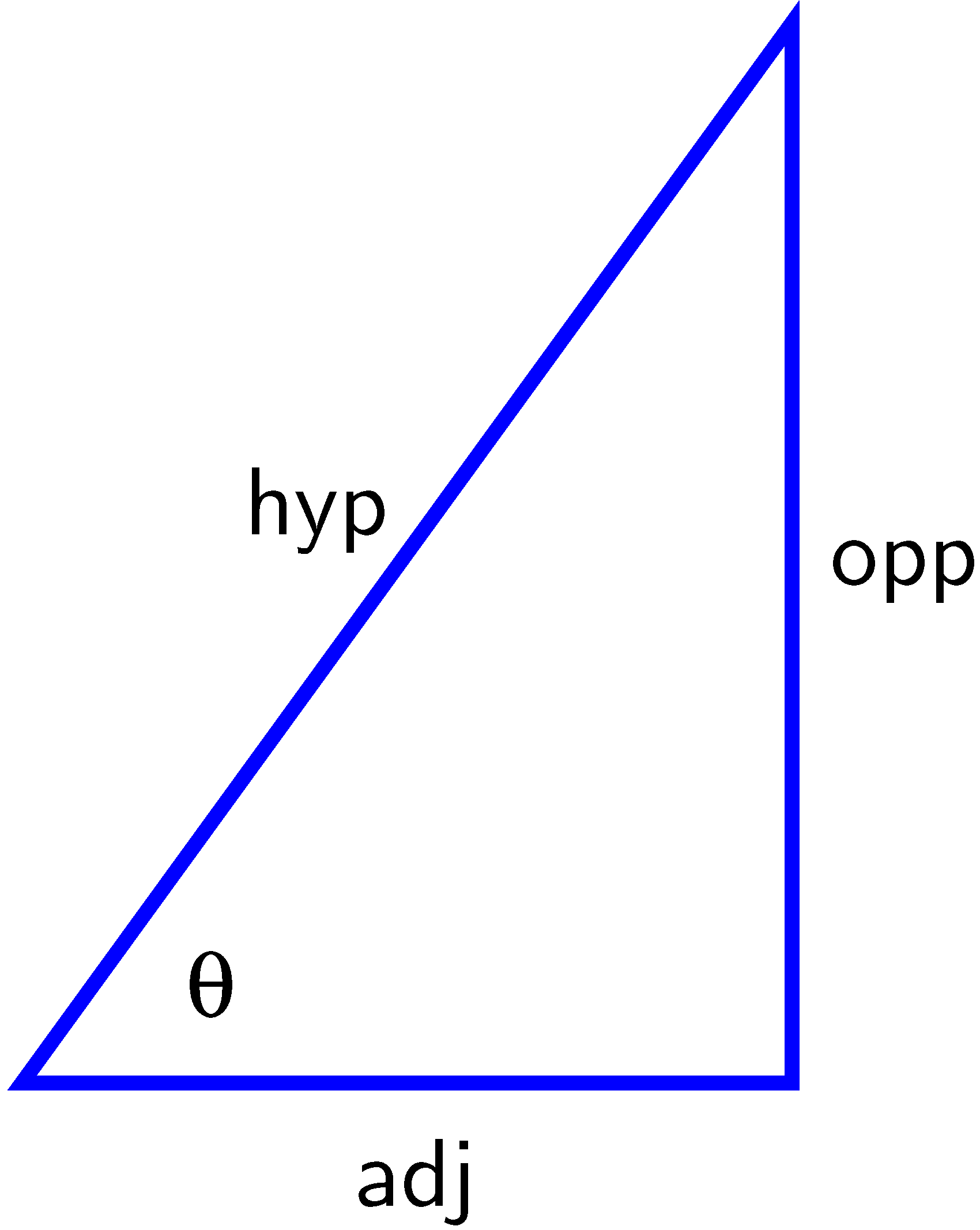- (a)
- What is the exact length of the triangle’s hypotenuse?
- (b)
- What is the exact value of ?
- (c)
- Rewrite your equation from (b) using the arcsine function in the form , where and are numerical values.
- (d)
- What special angle from the unit circle is ?
- How can we use inverse trigonometric functions to determine missing angles in right triangles?
- What other situations may require us to use inverse trigonometric functions?
Introduction
When we learned about trig functions, we observed that in any right triangle, if we know the measure of one additional angle and the length of one additional side, we can determine all of the other parts of the triangle. With the inverse trigonometric functions that we developed in the last two sections, we are now also able to determine the missing angles in any right triangle where we know the lengths of two sides.
While the original trigonometric functions take a particular angle as input and provide an output that can be viewed as the ratio of two sides of a right triangle, the inverse trigonometric functions take an input that can be viewed as a ratio of two sides of a right triangle and produce the corresponding angle as output. Indeed, it’s imperative to remember that statements such as
say the exact same thing from two different perspectives, and that we read “” as “the angle whose cosine is ”.Evaluating Inverse Trigonometric Functions
Like the trigonometric functions themselves, there are a handful of important values of the inverse trigonometric functions that we can determine exactly without the aid of a computer. For instance, we know from the unit circle that , , and . In these evaluations, we have to be careful to remember that the range of the arccosine function is , while the range of the arcsine function is and the range of the arctangent function is , in order to ensure that we choose the appropriate angle that results from the inverse trigonometric function. This is why our emphasis is now turning to the graphs of these functions.
In addition, there are many other values at which we may wish to know the angle that results from an inverse trigonometric function. To determine such values, one can use a computational device (such as Desmos) in order to find an approximation; however, in this class we leave it in the form , as this is the exact value.

We can now find the remaining leg’s length and the remaining angle’s measure. If we let represent the length of the horizontal leg, by the Pythagorean Theorem we know that
and thus so . Calling the remaining angle , since , it follows thatWe can also use inverse trigonometric functions to solve equations that up until now, have been unsolvable for us.
However, we need to be careful. This isn’t the only solution to our equation. The picture below reminds us that there are infinitely many places where the graphs of and intersect.
Our strategy to find all solutions to is to first find all solutions within a single period, then add all multiples of . This should be familiar from an earlier section. Note that the interval contains a full period of , and from the graph above, there are two solutions on that interval: one on the interval and one on the interval . The solution on the interval is the solution we’ve already found, , since we know the range of is .
As in similar problems we’ve done before, the other solution has the same reference angle as . We know that lives in Quadrant I, since it corresponds to a positive cosine value, so it is its own reference angle. The other solution therefore, has reference angle and because cosine is positive, lies in Quadrant IV. A Quadrant IV angle that has this reference angle is given by . Since and give a complete list of all solutions on one period of cosine, a complete list of all solutions to our original equation is for all integers .
Let’s consider the composite function .
Does it makes sense to consider this function? Let’s think
This function makes sense to consider since the arcsine function has range , on
which we may evaluate the cosine function. In the questions that follow,
we investigate how to express without using trigonometric functions at
all.
- (a)
- What is the domain of ? The range of ? The domain of is the domain of the inner function, , which produces values within the domain of the outer function, . As noted at the beginning, since the range of is contained in , the domain of , the domain of is simply the domain of .
The domain of is therefore .Now, the range of will be the output of the outer function when the input is the range of the inner function. In other words, we are looking for the values that attains on the interval . Since cosine is symmetric about the -axis, this is the same as the values attained by on the interval . Thus, we have a range of .
- (b)
- Since the arcsine function produces a value we can consider as an angle, let’s
say that , so that is the angle whose sine is . By definition, we can picture
as an angle in a right triangle with hypotenuse and a vertical leg of
length , as shown in the image on the left below. Use the Pythagorean
Theorem to determine the length of the horizontal leg as a function of .
First we recall the Pythagorean Theorem, , where is the hypotenuse of a right triangle with legs of lengths . Hence, in this instance, let’s denote the length of the horizontal leg by , so we have . In other words since a triangle leg will have positive length.


The right triangle on the left corresponds to the angle . The right triangle on the right corresponds to the angle .
- (c)
- What is the value of as a function of ? What have we shown about
?
- (d)
- How about the function ? How can you reason similarly to write in a way that
doesn’t involve any trigonometric functions at all? (Hint: let and consider the
right triangle on the right above.)
Using Inverse Trig in Applied Contexts
Now that we have developed the (restricted) sine, cosine, tangent, and secant functions and their respective inverses, in any setting in which we have a right triangle together with one side length and any one additional piece of information (another side length or a non-right angle measurement), we can determine all of the remaining pieces of the triangle. In the example that follows and the homework, we explore these possibilities in a variety of different applied contexts.
- (a)
- What is the exact measure of the angle the roof makes with the horizontal?
Looking at a side view of the house, we may divide the triangle of the roof in half to get a right triangle with legs 7 and 12 feet long. We want to find the angle of inclination ( in the diagram below), which satisfies the equation . In other words, we wish to find . As in Example 1, this does not match one of our known values, so we leave it in this form since this is the exact value.The image above is a side-view of the roof.
- (b)
- What is the exact measure of the angle at the peak of the roof (made by the
front and back portions of the roof that meet to form the ridge)?This will be double the angle at the top of the right triangle we used for part (a), since we had bisected this angle to form the right triangle. We now wish to find the angle satisfying . In other words, we are looking for . Once again, this is not a common angle, so it is the exact value. We need double this angle, so is our solution.
- (a)
- When he throws the ball to first base, what angle does the line the ball travels make with the first base line?
- (b)
- What angle does it make with the third base line? Draw a well-labeled diagram.
- (c)
- What angles arise if he throws the ball to second base instead?
- (a)
- At what angle is the camera tilted when the rocket is ’ off the ground?
- Now, rather than considering the rocket at a fixed height of ft, let its height vary and call the rocket’s height .
- (b)
- Determine the camera’s angle, as a function of , and compute the average rate of change of on the intervals , , and .
- (c)
- What do you observe about how the camera angle is changing?
Further Exploration
When composing trigonometric functions with inverse trigonometric functions, the expressions can often be rewritten as algebraic expressions of . We will see two examples of this below.
- (a)
- .Recall that we found this expression in Example 2, part (d), to be Now, we must find the domain for which this is true.
We start by checking the domain of the outer function, . Since the domain of the cosine function is all real numbers, we do not have any restrictions to consider here. Thus, our only concern is the domain of the arctangent function, which is also the real line. Thus, we see that
- (b)
- . given in
Again, to see this, we begin by setting , so that for in the domain of restricted cosine, . In other words, we have for in , and must find a formula for . Now, we must relate sine and cosine, for which we use the well-known trigonometric identity . Re-writing this to solve our equation, we see that we have , which is equivalent to Since sine is positive on the interval , where we defined , we choose the positive square root, and observe that , as desired.Finally, to establish the domain on which this equivalence holds, we recall that the domain of arccosine is . Since we consider , we want in . This is equivalent to in , and so our work is done.
A Note on Triangles
We can now use trigonometry to find angles of right triangles if we know the side lengths and side lengths of right triangles if we know the angles. You might be wondering, “What about triangles that are not right triangles? Can we use trig to learn anything about those?” It turns out that the Law of Sines and the Law of Cosines gives use a way to analyze other triangles beyond just right triangles using trig functions. For more information about this topic, see Laws of Sines and Cosines by Katherine Yoshiwara.

If we instead know the hypotenuse and one of the two legs, we can use either the arcsine or arccosine function accordingly.
Similarly, we may use this relationship along with the Pythagorean Theorem to find algebraic expressions for compositions of trig functions with trig inverses (see Example 2). The trig identities we learned in Section 10 are also useful to rewrite the compositions of functions as algebraic expressions (see Example 4).